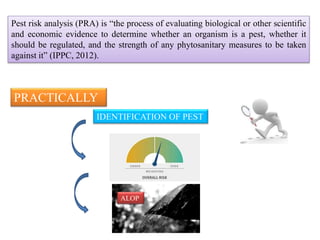Pra
- 1. Pest risk analysis (PRA) is ŌĆ£the process of evaluating biological or other scientific and economic evidence to determine whether an organism is a pest, whether it should be regulated, and the strength of any phytosanitary measures to be taken against itŌĆØ (IPPC, 2012). IDENTIFICATION OF PEST PRACTICALLY OVERALL PEST RISK ALOP
- 3. The Pest Risk Analysis guidelines ISPM Nos. 2 and 11
- 4. PEST RISK ANALYSIS ’āś PEST RISK INITIATION ’āś PEST RISK ASSESSMENT ’āś PEST RISK MANAGEMENT The pest risk analysis is seen as a key to export any farm product to other countries.
- 5. To assess the risk posed by a pathway, precise identification is essential EXAMPLES OF PATHWAYS DEFINITION OF PATHWAY
- 6. SHIPPING CONTAINERS WOOD PACKING CUSTOMS WAREHOUSE WIND EXAMPLES OF OTHER PATHWAYS
- 7. A pest is defined as ŌĆ£any species, strain or biotype of plant, animal or pathogenic agent, injurious to plants or plant productsŌĆØ [FAO 1990; revised FAO, 1995; IPPC, 1997] DEFINITION OF PEST
- 8. Performing a PRA for Thrips palmi, the possible pathways for the entry of this pest could be Cuttings of different ornamental plant species Foliage and cut flowers Clothing of international passengers Tropical Food produce EXAMPLE
- 9. The PRAArea: An area in relation to which a Pest Risk Analysis is conducted [FAO, 1995]
- 10. CABI.2007- Crop Protection Compendium EPPO.2005- Data Sheet on Quarantine Pests PRA conducted by other NPPOs or RPPOs INFORMATION GATHERING
- 11. If during the initiation of a PRA by a pathway no pest associated with that way is detected No assessment is carried out, this decision is reported CONCLUSION
- 12. whether a pest has or has not the characteristics of a quarantine pest Pest identity Scientific name : Tuta absoluta Family : Gelechidae Order : lepidoptera Class : Insecta PEST RISK ASSESSMENT
- 13. Pest Presence or Absence in the PRA area ’āś in all parts of the area ’āś only in some areas (specify the areas)except in specified pest free areas (which should be identified) ’āś only in some areas where host crop (s) are grown ’āś only in protected cultivation ’āś seasonally PresentAbsent Informnation Sources on Pest Status in an Area
- 15. Establishment is the perpetuation, for the foreseeable future, of a pest in an area after its entry [FAO, 1990; revised FAO, 1995; IPPC, 1997; formerly Established]. POTENTIAL FOR ESTABLISHMENT AND SPREAD
- 16. 8 ECOZONES 864 TERRESTRIAL ECOREGIONS
- 18. A potential harmful impact on plants, for Example: crops (e.g. loss of yield, or quality); the environment, for example, damage to ecosystems, habitats or species; or some other specified value, e.g. recreation, tourism, aesthetics. POTENTIAL FOR ECONOMIC, ENIRONMENT AND SOCIAL CONSEQENCES
- 19. LEVEL OF RISK UN ACCEPTABLE
- 20. Conclusions of pest risk assessment Risk acceptable? Risk unacceptable? PRA continues PEST RISK MANAGEMENT
- 22. Risk management measures should be proportional to the risk identified.
- 23. For market access for Indian table grapes in Australia, the Pest Risk Analysis (PRA) reached an advanced stage for which Australia was expected to issue the final notification.
- 24. APEDA made regular follow up with Ministry of Agriculture and USDAAPHIS regarding the PRA for market access for Pomegranates to USA with Irradiation as a mitigation measure. The export of pomegranates may commence from 2013 season.






![A pest is defined as ŌĆ£any species, strain or biotype of plant, animal or pathogenic
agent, injurious to plants or plant productsŌĆØ [FAO 1990; revised FAO, 1995; IPPC,
1997]
DEFINITION OF PEST](https://image.slidesharecdn.com/pra-160221062020/85/Pra-7-320.jpg)

![The PRAArea: An area in relation to which a Pest Risk Analysis is
conducted [FAO, 1995]](https://image.slidesharecdn.com/pra-160221062020/85/Pra-9-320.jpg)





![Establishment is the perpetuation, for the foreseeable future, of a pest in an area after its
entry [FAO, 1990; revised FAO, 1995; IPPC, 1997; formerly Established].
POTENTIAL FOR ESTABLISHMENT AND SPREAD](https://image.slidesharecdn.com/pra-160221062020/85/Pra-15-320.jpg)








